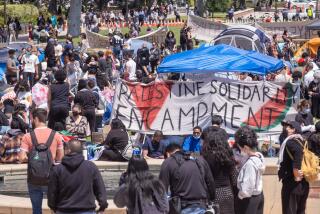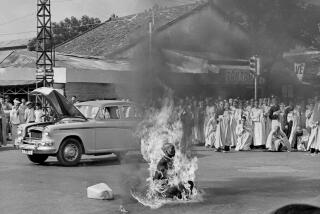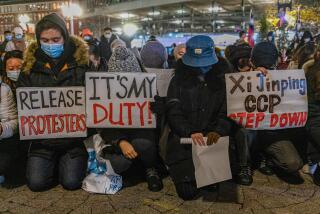Thousands Mourn Death of New Tibetan Martyr
NEW DELHI — Thousands of mourners on Thursday crowded the road to Dharmsala, India, to glimpse the body of a new kind of Tibetan martyr, while the movement’s most famous member worked half a world away in the United States.
The distance was more than physical.
The self-immolation earlier this week of Thupten Ngodup, a Tibetan exile protesting the Chinese occupation of his homeland, and the dramatic response by thousands of Tibetan exiles here, highlighted a growing frustration among many Tibetans that the 4-decade-old strategy of peaceful resistance--as advocated by their spiritual leader, the Dalai Lama--has failed to bear fruit.
A growing number of Tibetans, many young and living outside Tibet, say the strategy employed by 20th century giants such as Mahatma Gandhi and the Rev. Martin Luther King Jr. has proved impotent against the totalitarian regime in Beijing. Many say they want a more active policy--of hunger strikes and demonstrations, with some even willing to resort to violence.
“For the last 40 years, we have been telling our story to the world, and we have no results,” said Tseten Norbu, president of the 14,000-member Tibetan Youth Congress, one of the new forces in the exile community, which is based in Dharmsala. “There is a growing feeling in the Tibetan community that the Dalai Lama is being taken advantage of.”
The frustration felt by many Tibetans has emerged even as their cause has won supporters around the world. The restiveness threatens to complicate an already delicate situation involving Tibetan human rights and U.S.-China superpower relations.
Ngodup, 50, a former Buddhist monk, set himself ablaze Monday after Indian police forcibly ended a hunger strike by six other Tibetans who had fasted for more than 40 days. He died Wednesday.
Ngodup and the others in the Indian capital were demonstrating in hopes of forcing the United Nations to take steps to recognize Tibet, including investigating reported human rights abuses by the Chinese government and holding a plebiscite to decide Tibet’s future.
The hunger strikes carried an air of desperation whose force even the Dalai Lama could not resist. While repeating that hunger strikes and suicide betray the Buddhist tradition of nonviolence, he conceded that he could not offer the protesters any alternatives.
“For many years, I’d been able to persuade the Tibetan people to eschew violence in our freedom struggle,” he said after visiting Ngodup in the hospital before his death. “Today, it’s clear that a sense of frustration and urgency is building up among many Tibetans as evidenced by the unto-death hunger strike and the tragic incident.”
The Dalai Lama, regarded by many of his people as a living Buddha, or “enlightened one,” has led 130,000 exiled Tibetans for years in their fight to gain freedom for Tibet. He says he is seeking autonomy rather than independence from China, which has been accused by the United States and rights groups of widespread brutality and inhumane treatment.
Yet China, which invaded Tibet in 1950 and annexed it nine years later, has not yielded. “In that sense, my efforts have failed,” the Dalai Lama said.
As if to underscore its defiance, the Chinese government has failed to mention the hunger strikes or suicide in state-run television or newspapers. On Thursday, the Beijing government accused the Dalai Lama, the 1989 Nobel Peace laureate, of plotting independence for Tibet and spurning overtures from Beijing. “He has no sincerity toward dialogue at all,” Chinese Foreign Ministry spokesman Tang Guoqiang said.
Twice in the past, the Dalai Lama intervened to stop Tibetans from carrying out hunger strikes. This time he did not, in part because leaders of the Tibetan Youth Congress, which helped organize the fasts, sought his assurance beforehand that he would let them go on.
Hunger strikes and self-immolation carry a particular poignancy for Buddhists, who are obliged to forswear the killing of living things. Ngodup’s death recalled scenes from the mid-1960s, when Buddhist monks set themselves ablaze to protest their treatment at the hands of the South Vietnamese government.
“Self-immolation is one of the most dramatic beginnings,” said Mahendra Lama, a professor at New Delhi’s Jawaharlal Nehru University.
Ngodup was taken to a New Delhi hospital, where he was visited by the Dalai Lama. He died after the Tibetan spiritual leader left India for a U.S. visit. The Dalai Lama, who spoke in New York on Thursday, is also to meet Wei Jingsheng, a recently released Chinese dissident.
On Thursday, Ngodup’s body was carried on the road that winds up the Himalayan foothills to Dharmsala. Thousands turned out as the procession made its way to Tsuglagkhang, the Dalai Lama’s shrine.
“I have come because I am a Tibetan citizen and feel it is my duty to be with my brothers and sisters who are fighting for the cause,” said Kalden Norbu, 47. “I am ready to sacrifice my life for my country.”
Support for the Dalai Lama also ran high--underscoring the confusion faced by many Tibetan exiles. “I support the hunger strikers. Nonviolence is the only path,” said Dorma Dorjee, 25, of New Delhi. “I feel frustrated by the whole situation.”
Exile leaders said that, despite the frustrations, most Tibetans will keep to the peaceful path laid out by the Dalai Lama. Even Ngodup, on his deathbed, had tried to fold his hands in the traditional Tibetan fashion when the Dalai Lama visited him in the hospital, supporters said.
“His Holiness has always stated that a nonviolent freedom struggle will take longer,” said Kelsang Gyaltsen, an assistant to the Dalai Lama. “In many cases with political problems, if you resolve them with force and violence, you have achieved one goal but have sown the seeds of other problems. With a nonviolent approach, once you succeed, you have a solution with no side effects.”
Filkins, The Times’ New Delhi Bureau chief, reported from Islamabad, Pakistan. Sharma, a bureau researcher, reported from New Delhi.
More to Read
Sign up for Essential California
The most important California stories and recommendations in your inbox every morning.
You may occasionally receive promotional content from the Los Angeles Times.









